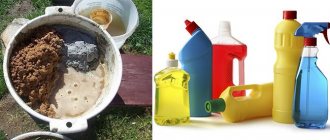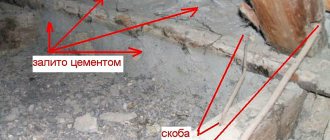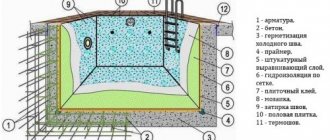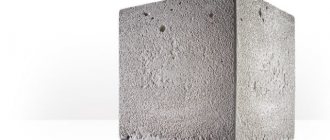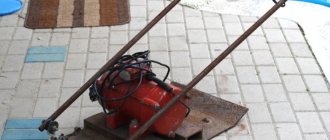- 1 What is it used for?
- 2 Methods
- 3 Other ways
- 4 Recommendations
- 5 Compaction factor
- 6 What does the coefficient depend on?
- 7 Conclusions
The technology for erecting concrete structures involves preparing a concrete mixture and compacting it. There are cases when, when mixing a solution, cavities appear inside, which can disrupt the structure and reduce its density. Because of this, cracks appear in the product, which can ultimately lead to the destruction of concrete structures. During the compaction process, specialists remove air and excess liquid from the solution, due to which it becomes more dense. Thus, the product is stronger and more durable.
What is it used for?
Compaction of concrete is considered the most critical stage in laying cement mixtures. The concrete coefficient and the main characteristics of the product will depend on how carefully this action is performed. During the procedure, specialists process the concrete surface manually or using mechanical devices, removing cavities. This makes it possible to achieve homogeneity of the concrete solution and increase the adhesion of the composition to other structural elements.
Return to contents
Methods
Builders use the following types of devices when compacting the mixture:
- surface (for the top layer of cement);
- deep (large concrete structures);
- external (installed before compaction at the edge of wooden formwork or a container with cement mortar);
- vibration platforms (used at specialized enterprises).
There are different ways to compact cement mortar:
- Manually. It is practiced mainly in private construction work, as this method helps to save money on the purchase of equipment. Manual compaction is used in cases where it is necessary to process the mixture in small quantities. As a rule, in such cases the solution is also made by hand. The concrete surface is processed with a crowbar, tamper, shovel, etc.
Baying the foundation after pouring concrete.
Bayoneting. To perform this procedure, a metal rod (for example, a reinforced rod) weighing up to four kilograms is used. In this case, it is desirable that the tip of the rod be rounded. It is used to “pierce” concrete. Experts recommend piercing the entire surface of the container with the mixture. This method allows you to compact crushed stone, displace air and excess liquid.- Manual tamping. This method is usually used for compacting heavy concrete mortars. For unreinforced structures, builders use manual or mechanical tampers. Compaction should be done carefully and layer by layer. However, the thickness of the compacted layer should be no more than fifteen centimeters.
Return to contents
This will definitely interest you:
- Window and door lintels
- Armopoyas Reinforced belt Do-it-yourself Armopoyas
- Formwork How to make formwork for armored belts, lintels or strip foundations
- cesspool
- How to make a blind area correctly: insulating the blind area.
- Monolithic strip foundation for a house made of gas silicate blocks Reinforcement of strip foundation
- Armopoyas (reinforced belt) Reinforced concrete beams over openings
- Bitumen, bitumen mastic
- Modern roofing materials
- Possible cold bridges during the construction of a country house
other methods
Other compaction methods include:
Mechanical. Builders resort to this method when processing significant volumes of cement. The process is carried out using special devices, which include surface and internal vibration devices. Specialists also use mechanisms that are attached to wooden formwork or a container with a mixture. In particular, surface vibratory screeds allow only the top concrete layer to be compacted. Therefore, builders use it for products made from a thin layer of concrete: bases for tiles, floors, roads, etc. The internal vibrating screed, in turn, is considered the most effective in comparison with other mechanisms. In addition, such devices are easy to operate and are used for processing concrete in hard-to-reach areas. Vibrators, which are installed on wooden formwork or form, are securely fastened, compacting the mixture due to vibrations of the formwork transmitted to the cement mortar. Formwork devices are indispensable for concreting products of unusual shapes.
Vibration compaction. Produced using portable and stationary devices. The use of portable mechanisms for precast concrete structures is limited. They are used to create large and heavy products. Vibrating platforms are necessary in the production of reinforced concrete in factories operating according to special schemes. The modern market offers a large selection of vibrating platforms, including electromagnetic, pneumatic, combined, etc.- Pressing. Experts less often resort to this method of compacting the mixture, although it is considered effective because it allows increasing the strength of the mortar with low cement consumption. This method is not widely used due to its high cost. The pressure required for pressing concrete should be from 10 MPa. Presses that have similar power are used in the shipbuilding industry to create new ships. However, it should be noted that the cost of such pressing devices does not allow them to be used for private construction work. During the preparation of cement mortars, pressing should be used only as an additional load during vibration compaction. The required degree of pressure can be no higher than 1 kPa. The modern market offers flat and profile dies. In particular, profile stamps are needed to give the desired texture to a particular product. This is how concrete panels, flights of stairs and other elements and structures from this material are made. This type of pressing is called stamping. Another type of pressing is rolling. In this case, the pressure on the cement mortar is carried out by the roller. This allows you to reduce energy consumption due to reduced pressure during pressing. But the method has one drawback related to the properties of the solution. In some cases, the material may be displaced or torn by the roller.
Concrete floors installed using the vacuum method.
Centrifugation. When rotating, the composition is compacted by adhering to the walls of the mold. After centrifugation, the density of the ingredients included in the cement mortar increases. In addition, approximately 30 percent of the water is removed from it. This helps increase the strength of concrete. The method allows you to make durable products. Centrifugation will require more cement than other types of compaction. The concrete solution will have the required viscosity. Otherwise, under the influence of the centrifuge, the composition will separate. The technology helps make power line supports, racks and pipes.- Vacuuming. The method allows you to rarefy the air, so that all excess is removed from the mixture under strong pressure. Accordingly, the density of the mixture increases.
Return to contents
Vibration compactors overview
Builders most often prefer the following models:
Sturm CV7120
This vibrator is durable and highly reliable. Although the portable unit is manufactured in China, it is sold under the brand of a German company that has proven itself well in our market.
The deep vibrator Sturm CV7120 is equipped with a flexible shaft, so it is convenient to use when compacting concrete for reinforced concrete walls, basements and columns.
Unit power 2000 W, vibration frequency 18,000 vibrations/min. At the same time, the equipment weighs a little more than 5 kg.
Advice! If your choice fell on this particular model, then it is better to immediately buy a spare shaft with a mace, since it will be difficult to find them from other suppliers.
The cost of Sturm CV7120 is from 14,000 rubles.
Hervisa Runner Plus 52
Another compact compactor for concrete belongs to the category of professional deep-water equipment. These units are produced by a Spanish manufacturer of the same name, which has been manufacturing vibration equipment for more than 30 years.
The main advantage of Hervisa is the presence of a voltage converter and reliable protection against power surges and overheating. At the same time, a vibrator weighing about 17 kg is capable of processing up to 40 m3 in just 1 hour. In addition, the unit is equipped with a reliable drive and a flexible shaft.
The power of the equipment is 1500 W at a vibration frequency of 12,000 vibrations/min. The unit costs about 109,000 rubles.
Red Mayak IV-98E
Those who prefer equipment from Russian manufacturers should purchase the Krasny Mayak IV-98E site model. This unit can be mounted both on the formwork and on the slab to create a surface vibrator.
The Red Lighthouse weighs 22.5 kg, but it is compact in size. The engine, shaft and unbalances of the unit are protected by a durable metal casing.
Red Mayak can be used not only for compacting solutions, but also for the manufacture of vibrating tables and other equipment.
The vibrator has a rather low power of 900 W at a vibration frequency of 3000 vibrations/min. The unit costs about 10,500 rubles.
Models such as Wacker Neuson AR 36/3/230 costing about 20,000 rubles, Caliber VER 1500 (from 3,000 rubles), Makita BVR450Z (13,500 rubles) and Grost VGB 4000 W (from 17,000 rubles) can also boast positive reviews. .
Before using the equipment, it is necessary to take into account the difference in the volume of the mixture before and after compaction.
Recommendations
To ensure that the cement composition is evenly compacted, the following recommendations must be followed:
- When installing wooden formwork, you should pay attention to the reliable fixation of parts. There should be no gaps on the structural elements (the concrete solution can be squeezed out through the cracks). It is necessary that the formwork is polished and smooth, otherwise it will leave dents on the product. In addition, voids may subsequently form in the body of the structure.
- Parts of wooden or plywood formwork, including wedges, must be securely fixed to prevent the boards from moving.
- When vibrating the composition, you should periodically change the position of the vibrating screed, otherwise the solution will be inhomogeneous and cavities will form.
- Experts advise not to spend a lot of time on the work, as this can cause delamination, which appears due to the fact that large crushed stone is knocked down at the bottom, and only cement mortar accumulates at the top.
Defects in concrete and reinforced concrete structures due to insufficient compaction of the concrete mixture.
Since the use of surface vibrating devices does not allow visual determination of the degree of density, during construction work an additional means is often used to help ensure the strength of the composition. To do this, builders add a solution with high plasticity to the existing composition. For this reason, the risk of product delamination increases. To avoid such a drawback, it is recommended to increase the amount of cement.
Return to contents
Compaction factor
The quality of a concrete composition can be assessed using one important criterion. We are talking about the compaction coefficient. The coefficient is determined as follows: the ratio of the specific gravity of the finished mixture to the value that was obtained in the absence of air bubbles inside is calculated. Thus, the acceptable value of the coefficient is considered to be 1. This indicator can be achieved using different methods of concrete compaction; the choice of methods will depend directly on the composition, purpose and fractions. Automated vibrating screeds significantly increase the quality of the solution.
Return to contents
The essence of the method
Every builder should know that one of the most important properties of concrete mortar is the ability to flow smoothly under the influence of its own mass or applied load. To achieve this effect, the mixture must be compacted. There are various ways to compact the cement-sand mass, depending on the size of the work site and the properties of the concrete. But the essence of each of them is that, under the influence of oscillatory movements developed by a vibrating device, internal friction occurs between the constituent particles. As a result, the loose and rigid mass becomes mobile and compacted.
Tamping a concrete composition involves removing excess air, which makes the structure porous and reduces its strength.
conclusions
Experienced builders claim that the stability and durability of the structure will depend on the density of the concrete solution. This must be taken into account if you want the product to serve you for more than one year. Timely measures will help to further increase the protection of the structure from damage and save money on restoration work. Universal vibration devices will produce high-quality concrete. Before carrying out construction work, you need to consult with specialists in advance and select the necessary equipment. Ergonomic vibrating devices allow construction workers to compact cement in a wide range of conditions.
To perform a small amount of construction work, professionals recommend using a portable vibrator weighing up to five kilograms. For larger-scale work, builders use large tools that allow them to effectively compact concrete in production with a large front of concrete work.


